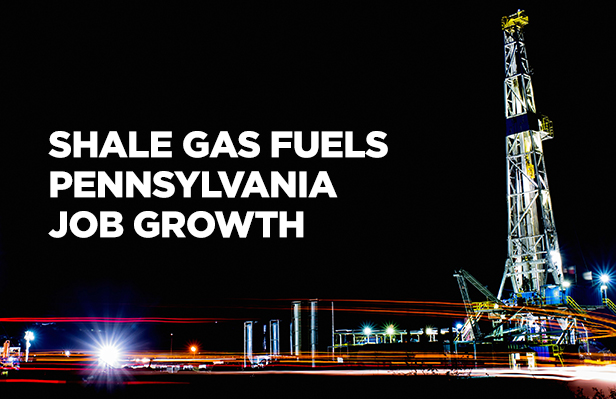Fact Sheet

The State of Natural Gas in Pa.
Pennsylvania’s regulatory and tax environment is stunting job growth and deterring investment. A decade after the Marcellus Shale boom, lawmakers are still debating how to tax the industry instead of fixing the policies contributing to Pennsylvania’s increasingly uncompetitive energy market.
High Taxes
- Pennsylvania is the only state in the nation that levies an “impact fee” on natural gas producers in addition to all other business taxes.
- Texas, a top natural gas producer, has no state income tax or corporate tax. Pennsylvania levies both, including the highest effective flat corporate income tax rate in the country.
- Of the top 10 natural gas producing states, two have no individual income tax, two have no corporate income tax, and only four collect death taxes. Pennsylvania levies all three taxes.
- Individual Pennsylvanians will pay for any new taxes.
- The Independent Fiscal Office (IFO) estimates Pennsylvania landowners will bear 7 percent of the tax and Pennsylvania natural gas consumers will bear almost 20 percent through higher utility bills. Beyond direct impacts, higher taxes will reduce jobs.
- For Pennsylvania to “be like other gas-producing states,” lawmakers would need to eliminate the state income tax and corporate tax.
Heavy Regulation
- The Marcellus Shale Coalition estimates Department of Environmental Protection (DEP) regulations finalized in 2016 raised operating costs by $2 million per well.
- Permit delays and fee increases have worsened this regulatory burden.
- Well permits must legally be issued in 45 calendar days, but some are taking up to 111 days—two to three times the statutory limit.
- DEP is facing a backlog of 560 pending well permits, which represents about $4 billion in delayed capital investment.
- Earth-disturbance permits, which do not exist in Ohio, are also delayed. In the Southwest district, permit reviews increased from 101 days in 2013 to 263 days in 2017.
- DEP claims staff shortages cause these delays and could be solved via a 150 percent fee increase. However, recent process changes implemented by the administration reduced permit backlogs, indicating more money is not the only solution. Here are a few examples of the successful changes:
- Shifting pending permits to regions with the capacity to review additional applications,
- Reallocating positions within the Office of Oil and Gas Management to equalize workload, and
- Targeting new hires in key permit review areas.
Declining Investment
- Capital investors are leaving Pennsylvania or avoiding the state, costing industry jobs. Since January 2015, Pennsylvania’s mining and logging sector lost more than 11,500 jobs.
- In the past few years, major investment deals have occurred in other states.
- ExxonMobil announced a $20 billion investment in the Permian Basin (Texas) that will create 45,000 high paying jobs.
- A Chesapeake Energy executive announced the Haynesville Shale (Louisiana) is roaring back. In the past year, rig operations have increase by 50 percent compared to early 2017.
- In contrast to growth in southern shale plays, the Marcellus Shale is largely devoid of new investments.
- Chevron’s CEO noted in Pittsburgh, “Chevron Appalachia has been operating at a minimum activity level for two years.”
- Braskem America took its $500 million propane cracking facility to La Porte, Texas instead of locating it alongside an existing facility at Marcus Hook due to a lack of guaranteed natural gas supply.
- Pennsylvania’s rig count remains far below the 2012 peak and down at least 10 rigs since January 2015.
- High taxes, heavy regulatory burdens, and limited infrastructure are depressing Marcellus Shale natural gas prices. For example, the New York Exchange (NYMEX) is recording prices around $3 per MCF, while interconnections in Pennsylvania such as the Leidy and Dominion hubs are hovering around $2 per MCF.
Additional Taxes Will Hurt Pennsylvania
- Adding the governor’s proposed severance tax on top of the impact fee would create an overall tax rate of 5.04 percent, making it one of the highest effective severance tax rates in country, including Texas and Louisiana.
- The IFO estimates the current impact fee is equivalent to a 2.9 percent tax.
- The Marcellus Shale Coalition estimates the governor’s proposal would equal a 2.14 percent tax, given a natural gas price of $3 per MCF.
- Pennsylvania residents already benefit from one of the most lucrative natural gas taxes among top producing states.
- The impact fee has generated more than $1.2 billion in new revenue since 2012.
- It generated $173 million in 2016, more than the severance taxes of Ohio, West Virginia, Arkansas, and Colorado combined.
- Pennsylvania landowners have collected more than $5.3 billion in natural gas royalties since 2012, according to the IFO.
- New taxes are not necessary to fund DEP oversight. Lawmakers should look to revising the impact fee disbursement formula before tapping taxpayers.
- In 2017, the impact fee distributed $93 million directly to local governments impacted by drilling, in contrast $6 million is set aside for DEP oversight.
- Too often, local government projects funded by the impact fee are unrelated to drilling impacts, such as funding for bike trails, a water feature, an amphitheater, tennis courts, pools, and playgrounds.
- In 2017, the impact fee distributed $93 million directly to local governments impacted by drilling, in contrast $6 million is set aside for DEP oversight.
High taxes, limited pipeline infrastructure and onerous regulations put Pennsylvania energy producers at a significant disadvantage. Higher taxes would give investors one more reason to overlook Pennsylvania.